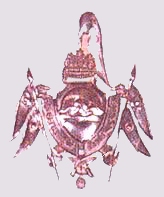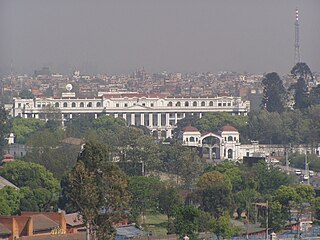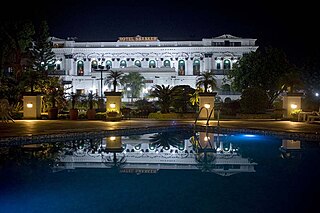
Maharaja Jung Bahadur Kunwar Ranaji, was a Khas Rajput (Chhetri) ruler of Nepal and founder of the Rana Regime in Nepal. Jung Bahadur took control of the government after killing an alleged usurper, Gagan Singh, who was accused of plotting with the junior queen in 1846 to become prime minister by putting the queen's son on the throne. His original name was Bir Narsingh Kunwar but he was popularly known as Jang Bahadur, a name given to him by his maternal uncle Mathabar Singh Thapa. Mathabar Singh Thapa used to call Jang Bahadur Jangay for his boldness.

Rana dynasty is a Chhetri dynasty that ruled the Kingdom of Nepal from 1846 until 1951, reducing the Shah monarch to a figurehead and making Prime Minister and other government positions held by the Ranas hereditary. They claimed Kshatriya status themselves. Rana dynasty is historically known for the iron-fisted rule. This changed after the Revolution of 1951 with the promulgation of a new constitution, when power shifted back to the monarchy of King Tribhuvan.

Singha Durbar is a palace in Kathmandu, the capital of Nepal. The palace complex lies in the centre of Kathmandu, to the north of the Babar Mahal and Thapathali Durbar and east of Bhadrakali Temple. This palace was built by Chandra Shumsher JBR in June 1908. The palace used to be one of the most exquisite and lavish of palaces in the world until the 1950s. Today it houses buildings of the Nepali Government, including the Pratinidhi Sabha, the Rastriya Sabha and several ministries.

The Government of Nepal is an executive body and the central government of Nepal. Prior to the abolition of the Nepali monarchy in 2008, it was officially known as His Majesty's Government.

Hotel Shanker in Kathmandu is a historic luxury heritage hotel opened in 1964 in a building dating to 1894. It is located in Lazimpat, next to the historic Narayanhity Palace Museum. The architectural style of the building is neoclassical. This palace was made for General Jit Shumsher Rana,. The hotel is characterised by exquisite and authentic objects d'art. For example, the carved windows displayed in the lobby bar are over 200 years old.

Thapathali Durbar was a palace complex in Kathmandu, the capital of the Nepal. Thapathali means abode of the Thapas. It was initially built by Nain Singh Thapa of the Thapa dynasty but was later occupied by Jung Bahadur Rana, as prime minister, the executive head of Nepal. The palace complex, located north of the Bagmati river, encompasses an impressive and vast array of courtyards, gardens, and buildings. Many palaces and buildings were built throughout late 1840s to 1900, initially by Nain Singh Thapa, a member of the aristocratic Thapa family and brother of Bhimsen Thapa, and later was acquired by Nain Singh Thapa's grandson Jung Bahadur Rana. Further additions were made by successive Ranas up to the 19th century.

Babar Mahal, Baber Mahal is a Rana palace in Kathmandu, the capital of Nepal. The palace complex, located north of the Bagmati river, was incorporated in an impressive and vast array of courtyards, gardens and buildings. Initially the palace was under Jung Bahadur Rana's Thapathali Durbar but later was separated and demolished and rebuilt by Chandra Shumsher Jang Bahadur Rana, as prime minister and the executive leader of Nepal.

Kaiser Mahal is a Rana palace in Kathmandu, the capital of Nepal. The palace complex, located west of the Narayanhity Palace, was incorporated in an impressive and vast array of courtyards, gardens and buildings.

Bag Durbar, is a palace built and resided by Thapa regime in Kathmandu, the capital of Nepal. The palace complex, located west of the Dharahara and Tundikhel, incorporates an impressive and vast array of courtyards, gardens and buildings. Initially the palace was owned by Amar Singh Thapa (Sardar) of Thapa regime and his descendant but later was occupied by Royals of Shah dynasty, and later by government of Nepal.

Bahadur Bhawan is a Rana palace in Kathmandu, the capital of Nepal. The palace complex, located west of Jamal, north of Keshar Mahal was incorporated in an impressive and vast array of courtyards, gardens and buildings. Initially the palace was built by Bir Shumsher JBR and was rebuilt by Rudra Shumsher JBR after its destruction by fire in BS 1962.

Lal Durbar is a Rana palace in Kathmandu, the capital of Nepal. The palace complex, located East of the Narayanhity Palace, was incorporated in an impressive and vast array of courtyards, gardens and buildings. Lal Durbar was built by Bir Shamsher JBR in 1890 CE.

Seto Durbar was a Rana palace in Kathmandu, the capital of Nepal. The palace complex, located south of the Narayanhity Palace, was incorporated in an impressive and vast array of courtyards, furnishings and guest halls. Seto Durbar was built by Bir Shumsher JBR in 1893 CE.
Jaulakhel Durbar was a Rana palace in Jawalakhel, Lalitpur, the capital city of Nepal. Jaulakhel Durbar was built by Bir Shumsher Jang Bahadur Rana in 1954 BS.
Bhatbhateni Durbar was a Rana palace in Kathmandu, Nepal. The palace complex, located in Hadigau, was incorporated in an impressive and vast array of courtyards, furnishings and guest halls. Bhatbhateni Durbar was built by Bir Shumsher JBR in 1888.

Harihar Bhawan is a Rana palace in Patan, Nepal the capital of the Nepal. The palace complex, located west of the Sri Durbar, was incorporated in an impressive and vast array of courtyards, gardens and buildings.

Shree Durbar is a Rana palace in Kathmandu, Patan, Nepal the capital of Nepal. The palace complex, located east of the Lazimpat Durbar next to Patan Dhoka, was incorporated in an impressive and vast array of courtyards, gardens and buildings. Sri Durbar was built by Chandra Shumsher JBR in 1927.
Bakhtawar Singh Thapa also spelled Bhaktawar, was a Nepalese military commander, politician, and governor. He acted as an aide of his brother Mukhtiyar Bhimsen Thapa and was appointed the commander of Samar Jung Company. He commanded the Bijayapur-Sindhuli Gadhi Axis in the first campaign of Anglo-Nepalese War and Makwanpur Gadhi Axis in the second campaign. Later, he became the governor of Palpa and died in the office.

Thapa dynasty or Thapa noble family was a Kshatriya political family that handled Nepali administration affairs between 1806 and 1837 A.D. and 1843 to 1845 A.D. as Mukhtiyar. This was one of the four noble families to be involved in the active politics of the Kingdom of Nepal, along with the Shah dynasty, Basnyat family, and the Pande dynasty before the rise of the Rana dynasty. At the end of 18th century, Thapas had extreme dominance over Nepalese Darbar politics alternatively contesting for central power against the Pande family. Bir Bhadra Thapa was a Thapa of Chhetri group and leading Bharadar during Unification of Nepal. His grandson Bhimsen Thapa became Mukhtiyar of Nepal and established Thapa dynasty to the dominating position of central court politics of Nepal.

The Pande family or Pande dynasty was a Kshatriya (Rajput-Chhetri) political family that directly ruled Nepali administration affairs since the 16th century to 19th century as Mulkaji and Mukhtiyar. This dynasty/family was one of the four noble family to be involved in active politics of Nepal together with Shah dynasty, Basnyat family and Thapa dynasty before rise of Rana dynasty. Pande dynasty is the oldest noble family to hold the title of Kaji. This family was decimated from political power in 1843 CE from the political massacre conducted by Prime Minister Mathabar Singh Thapa as a revenge for his uncle Bhimsen's death in 1839.

Kaji Bir Keshar Pande a Nepalese politician, military personnel and courtier in the Kingdom of Nepal. He was member of the Gora Pande clan of Gorkha and the son of Kaji Ranajit Pande. Bir Keshar Pande was the owner of Lazimpat Durbar. As Thapathali was abode of the Thapas, Lazimpat was abode of Pande family. At the time of the Kot massacre on 14 September 1846, Lazimpat Durbar was owned by Kaji Bir Keshar Pande and was massacred there. After which lazimpat Durbar was occupied by Kaji Mama Col.Tribikram Singh Thapa for 28 years until he left for Varanasi in 1875.



















